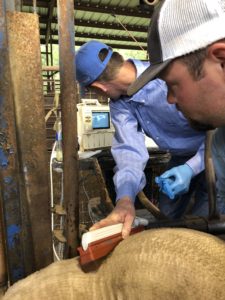Sheep were originally brought to the ranch by Palmer Giles (son of Alfred Giles, father of Robin Giles).
Sheep, along with the goats, play a vital role in controlling unwanted cedar. Sheep and goats have effectively replaced fire as a brush control method.
Sheep are raised at Hillingdon because of their ability to utilize forbs and weeds that might not be used by cattle and goats. Not only are sheep effective brush control managers, they also produce income from the production of their wool.
As with cattle, when we feel like our sheep need to be fed we start finding other places for them or start getting rid of some.
Lambing/Weaning
Ewes begin lambing in March. At about 6-12 weeks old, the lambs are vaccinated. Lambs are weaned at about 4.5 months of age.

Wool Samples
Before shearing our sheep, we take wool samples from the yearling ewes, yearling rams, and mature rams. A small patch of wool is clipped from the sheep, then sent to the Texas A&M Experiment Station in San Angelo where a laser scanner determines average fiber diameter.
The smaller the diameter, measured in microns (1/10,000 centimeter), the finer the fleece of wool. Finer wool means higher quality and a softer feel. Wool in garments worn close to the skin, and that does not itch, is less than 20 microns in fiber diameter. Hillingdon wool is in the 18 micron range, which makes it soft to the touch and makes for very comfortable garments. We have some rams with fleeces averaging 14 microns, which is exceptional.
This data can then be used as an aide in breeding selection. Having this individual data allows us to cull individuals from the herd that have undesirable fleeces.

Shearing
Our sheep are sheared once a year, in the spring. Ewes produce about 6-7 pounds of wool annually, while rams average 8-10 pounds annually.



Advances in Technology
It is important that our sheep not only produce a quality fleece, but also a quality carcass. Like our bulls, we ultra sound our ewes.

Research Opportunities
In November, we ship some of our ewe lambs to the Samuel Roberts Noble Foundation. The ewe lambs will be included in grazing/gain research of perennial cool season varieties planted in 1/16 acre paddocks. After the research trial is complete, the ewes come back to the ranch, are sheared, and are either kept for our own breeding program or are sold.
We are grateful to have the opportunity to work with this respected institute that provides such quality care for our livestock.
Wool
Once our sheep are sheared, the wool is baled and taken to Ranchman’s Wool and Mohair Export, Inc in Kerrville. There it can be stored until the market is favorable.
At times, we are contacted by individuals looking for clean wool. We keep clean wool on hand for occurrences such as these.
In order for wool to be considered ‘clean’, it must be washed in a gentle, spa-like process called scouring. This gentle process is a must or else the fiber will felt if aggressively agitated. When scoured, the wool goes through a scouring train which removes wax (lanolin), vegetable matter, and other impurities. Lanolin is very much desired for the cosmetic industry. It then passes through tubs with sets of rakes that move the fleeces through a series of scouring soap and water. At the end of the scouring tubs, the fleeces are rinsed, dried, and baled.
